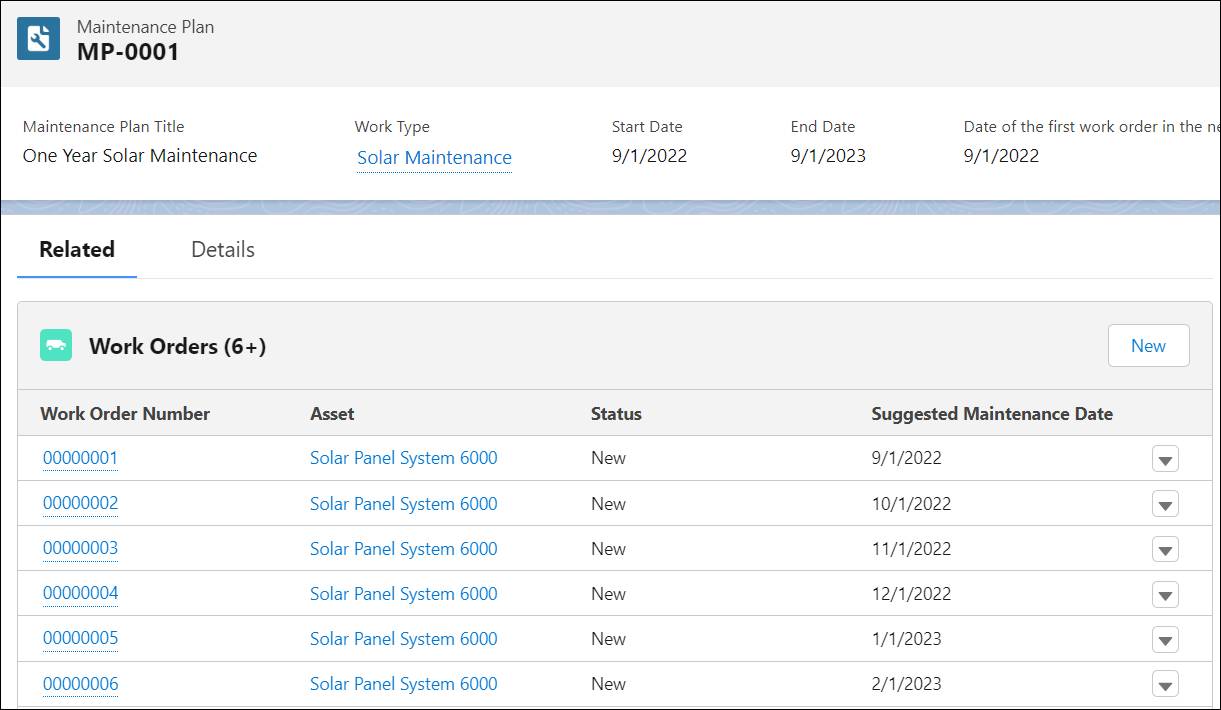Generate Work Orders
Learning Objectives
After completing this unit, you’ll be able to:
- Describe the parts of a work order.
- Generate work orders manually.
- Generate work orders automatically.
Introduction to Work Orders
A work order tracks work to be performed for a customer. At Ursa Major, for example, a work order can track a single solar panel maintenance visit. The work order describes what must be done. More granular tasks required to complete a work order can be represented as work order line items. For example, a work order line item to clean the solar panel and another one to inspect the panel’s wiring might be part of a larger maintenance work order.
Work orders and work order line items contain the information necessary to complete the job. Information like the account, contact, asset, and job priority. A work order or work order line item has related lists for work plans, work steps, service reports, and notes.
Let’s list some examples of things you can do with a work order or work order line item.
- Generate a service appointment. The service appointment is added to the schedule and assigned to a worker. Field Service tracks the details of the service appointment and work as the worker visits the customer to complete the order.
- Use work types as templates to standardize tasks and save time.
- Attach knowledge articles. The articles might describe how to complete a task in detail or list things to look out for when at a customer site.
- Track the progress of each task on a progress bar.
- View details on a mobile device.
Work orders originate from various sources, such as from a customer call or maintenance plan. Right now, you’re ready to generate monthly work orders from the Solar Maintenance plan.
Generate Monthly Work Orders
Using the maintenance plan we set up in the last unit, let’s generate our first batch of work orders for DreamHouse Realty’s monthly maintenance visits.
- If the maintenance plan isn’t open, from the App Launcher, select Maintenance Plans.
- Click the maintenance plan that you created in the previous unit, MP-0001.
- From the dropdown action menu, click Generate Work Orders.

- Dismiss the message, and check the Work Orders related list on the maintenance plan.
Boom! The first batch of work orders has arrived.
View Work Orders
Let’s see what’s on those shiny new work orders.

We see the work order numbers, the asset they’re associated with, their status, and their suggested maintenance dates.
Let's open one up to take a closer look.
- Click a Work Order Number.
- Click Related and view the Service Appointments related list.
Because you selected Auto-Generate Service Appointment when you created the work type, each work order already comes with a service appointment. The work orders and their service appointments inherited the work type’s date and duration settings. The Created by field in the work order Details page lists Automated Process, because the work order was automatically generated.
The maintenance asset’s Date of the first work order in the next batch has also auto-updated to 1 month after the Suggested Maintenance Date of the latest work order. This way, things are all set for the next batch.
Generate Work Orders Automatically
Sure, clicking that Generate Work Orders button feels good. But who wants to click a button when Salesforce can click it for you?
Let’s turn on auto-generation for our maintenance plan. You could have done this when you created the maintenance plan and never have had to click Generate Work Orders at all, but let’s fix that now.
- From the dropdown action menu on the MP-001 maintenance plan, click Edit.
- Select Auto-generate work orders.
- Click Save.
When you’ve set it up, automated work order generation runs 3 times a day and automatically creates work orders for all relevant maintenance work rules.
If you have trouble automatically generating work orders, check the Maintenance Plan feed for the error message. Then fix the error, manually generate a work order to verify that it works, and switch back to generating work orders automatically again.
In this unit, you generated work orders manually. Then you viewed a work order to see what’s included and generated work orders automatically. Now you know how to maintain assets regularly by setting up maintenance plans with work rules and assets and using them to generate work orders.
Resources
- Salesforce Help: Guidelines for Generating Work Orders from a Maintenance Plan
- Salesforce Help: Set Up Work Order Management for Field Service
- Salesforce Help: Manage Work Orders for Field Service
- Salesforce Help: Troubleshooting Work Order Generations